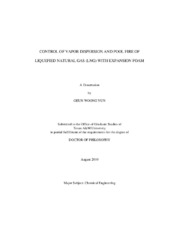| dc.description.abstract | Liquefied Natural Gas (LNG) is flammable when it forms a 5 – 15 percent volumetric
concentration mixture with air at atmospheric conditions. When the LNG vapor comes in
contact with an ignition source, it may result in fire and/or explosion. Because of
flammable characteristics and dense gas behaviors, expansion foam has been
recommended as one of the safety provisions for mitigating accidental LNG releases.
However, the effectiveness of foam in achieving this objective has not been sufficiently
reported in outdoor field tests. Thus, this research focused on experimental
determination of the effect of expansion foam application on LNG vapor dispersion and
pool fire.
Specifically, for evaluating the use of foam to control the vapor hazard from
spilled LNG, this study aimed to obtain key parameters, such as the temperature changes
of methane and foam and the extent reduction of vapor concentration. This study also
focused on identifying the effectiveness of foam and thermal exclusion zone by investigating temperature changes of foam and fire, profiles of radiant heat flux, and fire
height changes by foam. Additionally, a schematic model of LNG-foam system for
theoretical modeling and better understanding of underlying mechanism of foam was
developed.
Results showed that expansion foam was effective in increasing the buoyancy of
LNG vapor by raising the temperature of the vapor permeated through the foam layer
and ultimately decreasing the methane concentrations in the downwind direction. It was
also found that expansion foam has positive effects on reducing fire height and radiant
heat fluxes by decreasing fire heat feedback to the LNG pool, thus resulting in reduction
in the safe separation distance. Through the extensive data analysis, several key
parameters, such as minimum effective foam depth and mass evaporation rate of LNG
with foam, were identified. However, caution must be taken to ensure that foam
application can result in initial adverse effects on vapor and fire control. Finally, based
on these findings, several recommendations were made for improving foam delivery
methods which can be used for controlling the hazard of spilled LNG. | en |


